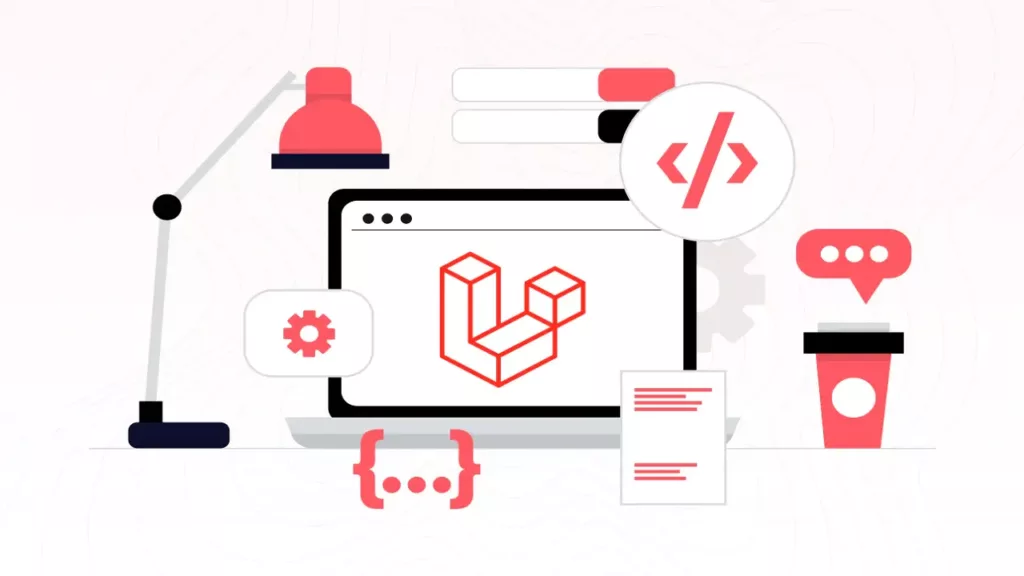PHP remains a dominant force in web development, powering 79% of all websites. Frameworks provide structure and streamline development with PHP, and two popular contenders are Laravel and CodeIgniter. This article provides a comprehensive comparison of Laravel and CodeIgniter, examining their strengths, weaknesses, and ideal use cases to help you make an informed decision for your next web development project.
Table of Contents
Overview
Both Laravel and CodeIgniter are open-source PHP frameworks that follow the Model-View-Controller (MVC) architectural pattern. This pattern promotes organized code by separating the application’s concerns:
- Model: Handles data and business logic.
- View: Manages the presentation layer and user interface.
- Controller: Acts as an intermediary between the Model and View, handling user requests and data processing.
While both frameworks share this foundation, they differ significantly in their features, complexity, and overall approach to web development.
Laravel

Created by Taylor Otwell in 2011, Laravel has gained immense popularity for its elegant syntax, robust features, and developer-friendly environment. It emphasizes developer experience and modern PHP development practices. Laravel is a leading PHP framework, holding a significant market share of 35.87%. In 2024, Laravel’s download count exceeded 50 million, with download statistics increasing by 15-20% per year.
Key Features of Laravel
- Blade Templating Engine: Provides a simple, yet powerful templating system with an intuitive syntax for creating dynamic and reusable views. Blade templates are compiled into plain PHP code, which effectively reduces the rendering time.
- Eloquent ORM: Offers an intuitive and expressive way to interact with databases, simplifying database operations and relationships. Eloquent ORM provides an ActiveRecord implementation for working with your database. Each database table has a corresponding “Model” which is used to interact with that table.
- Artisan Command-Line Interface: Provides helpful commands for tasks like generating code, managing databases, and running tests.
- Robust Security Features: Includes built-in protection against common vulnerabilities like cross-site scripting (XSS), cross-site request forgery (CSRF), and SQL injection. Laravel uses “providers” and “guards” to facilitate the authentication process. Guards authenticate users for each request they make, while providers retrieve users from your database.
Advantages of Laravel
- Rapid Development: Laravel’s elegant syntax, pre-built components, and extensive ecosystem contribute to faster development cycles. As the number one PHP framework, most web developers are familiar with Laravel. An expert Laravel developer could even build a 5 or 6 page website in a day or two.
- Scalability: Laravel’s modular architecture, caching mechanisms, and queue management system enable building scalable applications. Laravel applications can handle an increasing number of requests or data volumes without compromising performance.
- Maintainability: Laravel’s clear coding conventions and modular structure promote maintainable codebases. Websites built in Laravel are generally easy to maintain over time. Due to Laravel’s standout features, like clean code, MVC architecture (which separates logic and presentation), and OOP principles, maintaining a Laravel site over time is very straight forward.
- Large Community and Ecosystem: A vibrant community and extensive ecosystem provide ample resources, support, and third-party packages. Laravel boasts comprehensive and well-organized documentation, facilitating the onboarding of new developers to the framework. Moreover, the Laravel community is highly active and supportive, with numerous forums, tutorials, and resources available for developers to seek assistance and guidance.
Disadvantages of Laravel
- Steeper Learning Curve: Laravel can be more challenging to learn than CodeIgniter, especially for developers new to MVC frameworks or object-oriented programming. As prerequisites, you would need to know PHP at a beginner to medium level, along with basic object-oriented programming paradigms.
- Performance Overhead: While Laravel offers an array of features that simplify development, this convenience sometimes comes at the cost of performance. The framework’s extensive abstractions, middleware pipeline, and various components can introduce performance overhead, particularly when compared to leaner, micro-frameworks or custom-built solutions.
- Frequent Updates: Laravel’s active development community results in frequent updates. While regular updates are essential for security, bug fixes, and the addition of new features, they can pose challenges for projects that prioritize stability and continuity. Upgrading the framework version can cause applications to crash, and data might be permanently lost.
CodeIgniter

Created by EllisLab in 2006, CodeIgniter is known for its speed, simplicity, and lightweight nature. It provides a straightforward and flexible framework for building web applications. CodeIgniter is the most preferred framework for web development. In 2023, CodeIgniter had around 42% of the market share in the web frameworks world.
Key Features of CodeIgniter
- MVC Architecture: Promotes organized code by separating application logic from presentation. The MVC is the industry standard practice that separates the data, business logic, and presentation in web applications.
- Lightweight and Fast: CodeIgniter’s small footprint and minimal core system contribute to faster loading times and efficient performance. It can be quickly deployed and does not require a lot of server resources.
- Built-in Security Features: Includes protection against XSS, CSRF, and SQL injection. CodeIgniter offers built-in security features, such as input data validation, password handling, CSRF protection, and XSS filtering.
- Database Abstraction Layer: Simplifies database interactions and supports various database systems. CodeIgniter includes a database abstraction layer that allows you to create, insert, update, and delete data without writing SQL code.
- HMVC (Hierarchical Model-View-Controller): HMVC is an advanced extension of the default MVC structure in CodeIgniter. It allows for the development of modular applications by enabling nested MVC sub-modules, making it easier to manage complex projects.
Advantages of CodeIgniter
- Ease of Learning: CodeIgniter is relatively easy to learn, making it suitable for beginners and developers who prefer a less complex framework. It comes with a simple and intuitive syntax.
- Speed and Performance: CodeIgniter’s lightweight nature and efficient design result in faster loading times and improved performance. It is one of the quickest frameworks out there. Not only is it speedy to develop, but it also has faster loading times.
- Flexibility: CodeIgniter allows developers to use their preferred coding style and offers customization options. It offers great flexibility to developers to use their preferred coding style and development approach.
- Simple Configuration: CodeIgniter is easy to configure and set up, requiring minimal effort to get started. CodeIgniter PHP framework is made of a linear arrangement and has a freely usable folder set-up.
- Error Handling: CodeIgniter has a simple error-handling system. It helps detect errors and resolve issues efficiently. It provides functionalities for custom error handling and allows users to configure error reporting levels.
Disadvantages of CodeIgniter
- Limited Built-in Features: CodeIgniter has fewer built-in features compared to Laravel, potentially requiring more manual coding or the use of third-party libraries. Compared with Laravel, CodeIgniter provides the basic capability, but there are not as many integrated functions.
- Less Scalability: While CodeIgniter can handle moderately sized projects, scaling for larger applications may require more effort and custom solutions. As the project grows in complexity, managing scalability can become challenging with CodeIgniter.
- Outdated Documentation: Some developers have reported challenges with outdated or incomplete documentation.
Head-to-Head Comparison

| Feature | Laravel | CodeIgniter |
| Release Date | 2011 | 2006 |
| Architecture | MVC (strict) | MVC (flexible) |
| Learning Curve | Steeper | Easier |
| Performance | Can have overhead, requires optimization | Generally faster and lightweight |
| Scalability | Highly scalable | Can be challenging for larger applications |
| Database Support | MariaDB, MYSQL, PostgreSQL, SQLite3, SQL Server | MySQL, PostgreSQL, SQLite3 |
| Templating Engine | Blade Template Engine | PHP proprietary |
| Database Model | Object-oriented | Relational object-oriented |
| Programming Paradigm | Object-oriented event-driven functional | Component-oriented |
| HTTP Support | Supports custom HTTPS routes | Doesn’t support HTTPS |
| Authentication | Offers built-in authentication | Offers built-in authentication (Shield) |
| Unit Testing | Offers built-in unit testing support | Doesn’t offer built-in unit testing support |
Choosing the Right Framework:
The choice between Laravel and CodeIgniter depends on your project’s specific needs and your development team’s expertise.
Consider Laravel if:
- You are building a large, complex application.
- Scalability and maintainability are crucial.
- You need a framework with robust security features and a large community.
- Your team is comfortable with object-oriented programming and MVC architecture.
Consider CodeIgniter if:
- You are building a small to medium-sized project.
- Speed and simplicity are priorities.
- You need a framework with a gentler learning curve.
- Your team prefers a more flexible and customizable framework.
When considering performance and scalability, CodeIgniter might be a better option, as it has a minimal footprint and less overhead. Laravel, on the other hand, has more optimizations and caching mechanisms, making it suitable for large and complex websites with advanced features.
In terms of security, Laravel offers more holistic and robust security toolkits. While CodeIgniter needs more manual configurations to set advanced security features, Laravel has built-in tools to ensure high-end security.
CodeIgniter is flexible and enables effective customization since it adopts a minimalistic design with the least constraints. Laravel also provides customization features with its rich ecosystem and a feature-rich environment, with extensive possibilities.
Mutual Influence and the PHP Ecosystem
Interestingly, Laravel and CodeIgniter have influenced each other and the PHP ecosystem. Laravel’s success pushed Symfony (another PHP framework) to improve its user experience, making it more user-friendly. Symfony, in turn, had better robustness, debugging, and error handling, which forced Laravel to improve in those areas. CodeIgniter, with its focus on simplicity and getting things done, provided an alternative to Symfony and Zend, similar to Laravel in its approach.
Conclusion: What Does This Mean For You As Developers
Both Laravel and CodeIgniter are valuable tools in the PHP developer’s arsenal. But ultimately, what does this mean for developers?
- Choice of Framework Matters: Developers need to carefully consider project requirements when choosing between Laravel and CodeIgniter. The choice impacts development speed, scalability, maintainability, and overall project success.
- Understanding Trade-offs: Developers must understand the trade-offs between each framework. Laravel offers robust features and scalability but has a steeper learning curve and potential performance overhead. CodeIgniter is faster and easier to learn but has fewer built-in features and may be less scalable for large projects.
- Skillset and Expertise: The choice also depends on the developer’s or team’s skillset. Developers experienced in object-oriented programming and MVC architecture might prefer Laravel. Those seeking a simpler framework with a gentler learning curve might opt for CodeIgniter.
- Staying Updated: Developers should stay updated with the latest versions and trends for both frameworks. Frequent updates in Laravel, for example, require developers to keep their skills current.
- Project Size and Complexity: For small to medium-sized projects prioritizing speed and simplicity, CodeIgniter might be suitable. For large, complex applications requiring scalability and robust features, Laravel is likely a better choice.
- Security Considerations: Developers need to be aware of the security features offered by each framework. Laravel provides more built-in security tools, while CodeIgniter might require more manual configuration for advanced security.
- Community and Support: Laravel has a larger and more active community, offering extensive resources and support. This can be beneficial for developers seeking assistance or guidance.
CodeIgniter, with its lightweight nature and minimal footprint, excels in speed and performance. It is an excellent choice for small to medium-sized projects where rapid development and simplicity are paramount. Laravel, while potentially having more overhead, shines in its ability to handle complex tasks and build scalable applications. Its robust features, elegant syntax, and extensive ecosystem make it well-suited for large, complex projects where scalability and maintainability are crucial.
Ultimately, the “best” framework depends on your specific needs and priorities. If you need a framework that is easy to learn and use, and you prioritize speed and performance, CodeIgniter is a great option. If you need a framework that is more scalable and has more features, and you are not as concerned about speed, Laravel is a better choice.